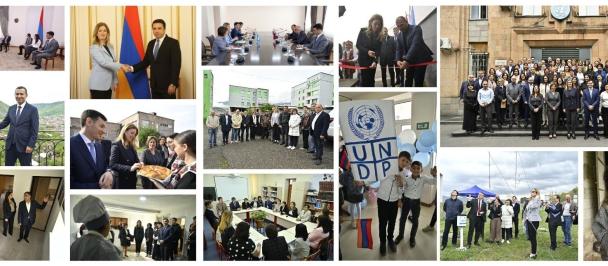Integrated Support to Rural Communities
What we do
According to the National Statistical Service of Armenia, approximately 37 percent of Armenia’s population is living in rural communities. The majority of local population in rural areas is engaged in substantive agriculture on small farms with an average monthly income of USD 110. The poverty level among rural population is 36 percent. Rural communities are suffering from deprivations caused by the multidimensional poverty, including restricted access to quality infrastructures. Meanwhile the income generating opportunities in the rural areas are limited by the environmental risks and low production capabilities. All these factors contribute to the decline both in living standards and income level increasing the intensity of rural poverty.
UNDP’s extensive experience in development cooperation in Armenia indicates that promoting sustainable development requires an integrated approach which targets social, economic and environmental pillars of development to raise the resilience of the local population to social-economic and natural risks.
“Integrated Support to Rural Development: Building Resilient Communities” project, funded by the Russian Federation, is implemented in borderline communities of Tavush region of the Republic of Armenia, in close partnership with the Ministry of Territorial Administration and Development. The overall goal of the project is to ensure balanced development of RA regions through an integrated socio-economic approach. The project aims at raising the quality of life and income level of the local population in 45 borderline communities of Tavush region.
The project has three main components:
1. Development planning, which includes elaboration of integrated community development plans for 45 communities through direct engagement and participation of local population.
2. Community economic sustainability through capacity building, enhanced production capability and enterprise development, including construction of small greenhouses, small-scale contemporary agro-processing units, collection centres, etc.
3. Community sustainability enhanced through rehabilitation of community infrastructures with focus on energy efficiency, introduction of water saving technologies, ensuring access to safe drinking water, etc.
Some results so far
- The Project has already helped 28 communities to create integrated community development plans, provided 56 greenhouses, 19 small-scale agro-production units (fruit dryers, wineries, bakery, sewing shop), planted 30 ha of fruit orchards.
- Three community development funds will manage two agricultural machinery pools, one collection center for forest fruits and non-timber products, and one gristmill/wheat collection center.
- Four community infrastructures were rehabilitated targeting at increased energy efficiency and saving of resources (LED street lighting, climate-proofing of culture house).
- 10 ha of drip irrigation systems help the communities to preserve the valuable water resources and make it available to more farmers. The Project also reconstructed two irrigation water lines multiplying the amount of water available for farming.
- Seven school canteens were renovated bringing them into a clean and appealing condition where pupils receive warm meals daily.

 Locations
Locations


